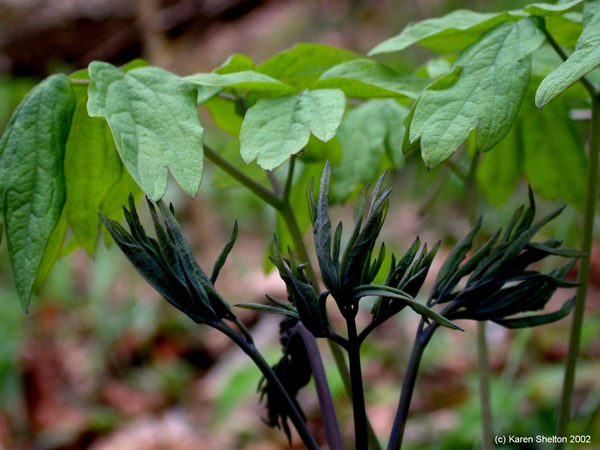Blue Cohosh Herb
Author: Karen Bergeron (c) 2007 Updated 03/11/2019
Caulophyllum thalictroides
Blue Cohosh is an attractive woodland herb that is becoming endangered due to over harvesting. It is a small plant that rarely grows more than 2 1/2 feet ( .60 m) in height. In Tennessee, it blooms in early April and is usually found on wooded slopes.
Blue Cohosh was used historically as a uterine tonic and to help with difficult labor. The seeds are roasted and used for a coffee substitute. (WebMD) There is a high potential for toxicity using Blue Cohosh. It is my opinion that the reasons not to use it outweigh any possible benefits because of possible toxicity and interactions with medications.
Blue Cohosh berries are reported to be poisonous. The plant is a lovely addition to shade gardens but is not considered safe for general or edible use. Use only under advice from a qualified medical practitioner. Use by pregnant women can cause harm to a mother as well as a fetus.
See contraindications for Blue Cohosh at Drugs.com
Blue Cohosh description
Blue Cohosh is a perennial herb that usually grows from 2-3 fett. The stem and opening leaves are blue in early spring. It has ternately-compound leaves with 2 or 3 lobed leaflets. A terminal panicle of greenish-yellow flowers (April-June) develops in the center of the three compound leaves. The plant produces blue, berry-like, toxic fruits in late summer.
Blue Cohosh is difficult to grow from seed, though root divisions do well in simulated woodland environment, and shade or part shade gardens. It needs rich, moist soil and deep shade to thrive. If you are interested in growing Blue Cohosh, email me at karen@altnature.com for information on where to get roots.

Blue Cohosh Herb Pictures by Karen Bergeron
Copyright 2006-2019. Permission required to use any herb pictures from this site.
Blue Cohosh Information Non-commercial Links
Safety and efficacy of blue cohosh (Caulophyllum thalictroides) during pregnancy and lactation
Alkaloids and saponins from Blue Cohosh.
Wildflowers and Plants of North Carolina




